Red rash? Constant licking and chewing that keeps you up all night? Rancid odor? Skin infections are an all too common problem for dog and cat owners. Many times, you think you have it cleared up, only to have the symptoms return in a month or two. Skin infections in dogs and cats are the itch that keeps coming back! Learn how to fight back with a holistic approach and get them under control for good.
What causes skin infections in dogs and cats?
There are several different types of skin infections that are common in dogs and cats. Knowing which one you are dealing with can be key to getting it cleared up. Some types of skin infections will require testing by the vet to diagnose, but there are some common types that are easier to identify at home.
- Bacterial Skin Infections – Look for red bumps or pimples, bullseye sores, redness, flaky skin, and/or a patchy, moth-eaten coat. Bacterial infections are often secondary infections due to allergies or flea infestation, as they frequently occur when your pet breaks the skin from lots of scratching, followed by licking and chewing. This type of infection will respond well to the treatment described below, and you may be able to clear it up completely at home in some cases.
- Demodex (mange) – circular or patchy hair loss with bald patches showing red to gray skin, usually around the eyes or muzzle, which aren’t painful or itchy; may spread over the whole body with bumps and crusts and swelling of the feet. This type of infection requires veterinary care.
- Ringworm (fungus) – a crusty circular area of hair loss, usually appearing first on the face and front legs. This type of infection will respond well to the treatment below, and you may be able to clear it up completely at home in some cases.
- Scabies (skin mites)- itching, scaling, hair loss, crusty skin, rancid odor. The treatment described below will give some relief, however, prescription medication will also be required.
- Seborrhea – thick dandruff or a greasy, smelly coat, redness, sometimes open sores. This type of infection will respond well to the treatment below, but see your vet if you are not seeing improvement in the first week or so.
- Yeast Skin Infections- If your dog or cat is bothered by itchy ears accompanied by lots of biting and licking of the paws, then a yeast infection is more than likely the cause. Yeast is a fungus that likes to grow in moist areas. Malassezia is the most common type of yeast found on a cat or dog’s skin and is usually found on the paws, ear canals, armpits, jowls, anal area, and any skin folds that your pet may have. This type of infection will respond well to the treatment below, and you may be able to clear it up completely at home in some cases.
How to Treat Skin Infections in Dogs and Cats at Home (and Banish Them For Good)!
- Give your pet a medicated bath, as directed in the tutorial below, 3 times a week for one month. After the first month, give the medicated baths once a week until the condition is completely cleared up and shows no sign of returning.
- Sometimes, skin infections are secondary infections due to allergies. Banish the most common allergens from your pet’s diet with a food that is free of wheat, corn, and soy. Also, begin giving your pet Omega 3, 6 & 9 Fish Oil for Dogs and Cats and Digestive Enzymes Plus Probiotics for Dogs and Cats to strengthen the immune system and improve gut health. Don’t be tempted to skip this step, as it will be the key that keeps your pet’s infection from coming back over and over again!
- See the vet if the condition is severe, or doesn’t respond quickly to the above protocol. If you don’t see some pretty dramatic improvement in the first week of medicated baths and dietary changes, see the vet. Sometimes, prescription medication will be required.
How to give your pet a medicated bath:
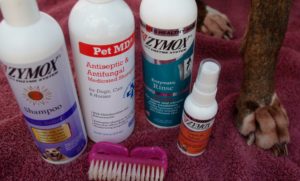
First, wet your pet down as you normally would.
Now, soap your pet up and scrub the infected area thoroughly with Pet MD – Antiseptic and Antifungal Medicated Shampoo using a soft brush (I’m using a soft fingernail brush.). This shampoo contains chlorhexidine and ketoconazole to treat both bacteria and yeast(fungus). Be sure to get in all the nooks and crannies around the toenails, in the pads of the feet, and in the skin folds really well, since this is where the yeast and bacteria love to hide. Allow this to soak on the skin for a full 10 minutes before rinsing
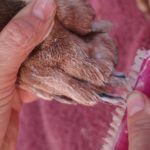
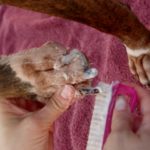
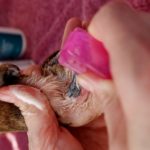
Follow with a second shampoo of Zymox Enzymatic Shampoo. This shampoo contains enzymes to further combat yeast and bacteria, and it also soothes and moisturizes itchy skin. Allow it to soak on the skin for 5 minutes before rinsing thoroughly.
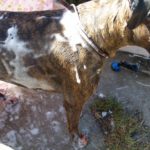
Now, apply Zymox Vitamin D3 Rinse all over, and allow to soak for 5 minutes before rinsing. This rinse provides natural inflammation relief with enzymes and Vitamin D3. You can follow this up with a direct application to the infected area only, and leave it on like a topical cream for additional, long-lasting relief.

Dry your pet as you normally would.
On non-bath days, use Zymox Topical Spray to soothe affected areas. Also, it is imperative that you do not allow your pet to lick or chew infected areas. If licking and chewing is a problem, you will need to put an e-collar on your pet to prevent licking and chewing.
Final Thoughts
Working in the pet care industry for over 20 years, I have seen pet parents drop literally thousands of dollars treating skin infections in dogs and cats. If you feel like you’ve tried everything to clear up your pet’s skin infection for good, only to have it return over and over again, why not give this protocol a try? Many times, taking a holistic approach to your pet’s care will get results, even when conventional treatments fail.

